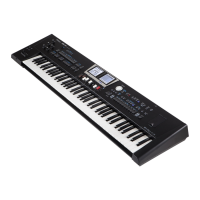‘Performance Edit’ parameters
139
functions, you must assign them to an optional pedal switch (p.
144).
There are three Ritardando functions: one for all rhythm patterns,
one for Ending patterns and one for ll-ins (see “Fill Ritardando”
above). They all use the “Tempo Change” settings on the following
page.
Parameter Setting
TempoCh Acc/Rit 5%~92%
TempoCh CPT 0~3825
TempoCh Fill Rit 5%~92%
“TempoCh Acc/Rit”: Allows you to set the degree (ratio) by which
the tempo changes when the “Acceler” or “Ritard” function is
triggered. Example: if the tempo is currently� = 100, the value “20%”
means that the tempo drops to � = 80 or rises to � = 120
“TempoCh CPT”: Use this parameter to specify how long a
ritardando/accelerando should take. In most cases, 480 CPT (i.e. one
measure) is probably the most musical choice.
“TempoCh Fill Rit”: This parameter allows you to specify to what
extent ll-in playback should be slowed down when the “Fill
Ritardando” function is on.
Using the Ritardando/Accelerando functions
For general applications (any rhythm division) proceed as follows:
a. Assign the “Arr Rit” or “Arr Acc” function to an optional
pedal switch (p. 144).
b. Press the [START/STOP] / [ */, ] button to start rhythm
playback.
c. Press the assigned pedal switch.
For Ritardandos that apply to Ending patterns proceed as follows:
a. Press the [START/STOP] / [ */, ] button to start playback.
b. Press the [ENDING] button twice in succession (“double-
click”).
Dynamic Arranger
The DYNAMIC ARRANGER function allows you to control the
volume of the accompaniments parts via the way you strike the
keys in the chord recognition area (velocity sensitivity).
It can be selected using [MENU] button “Performance Edit”
“Dynamic Arranger”.
Right Display
The following parameters can be edited:
Parameter Setting Explanation
Switch O, On
Enable or disable the Dynamic Arranger
function.
Parameter Setting Explanation
ADrum
-127 ~ +127
There are eight accompaniment parts:
ADrum (the drums), ABass (the bass)
and ACC1~6 (the melodic accompani-
ment parts).
Set the desired value with the dial or
the [DEC]/[INC] buttons.
You can specify positive and negative
sensitivity values.
Positive values mean that the volume
of the part in question increases when
you strike the chord recognition area
keys harder, while negative values
mean that the volume of the selected
accompaniment part increases as your
velocity becomes softer.
You could use extreme positive/nega-
tive “Acc” pairs (i.e. “127” and “–127”)
to alternate between those two lines
simply by varying your velocity. One
part would then only be audible when
you strike the keys softly, while the
other would only be triggered by high
velocity values.
Choose “0” for parts whose volume
should not be aected by your velocity
values.
Abass
Acc1
Acc2
Acc3
Acc4
Acc5
Acc6
.
Assign Switches
This page allows you to assign a function to the Assign Switches
two key. It can be selected using [MENU] button “Performance
Edit” “Assign Switches”.
Right Display
The following functions can be assigned to [S1], [S2], [S3], [S4] buttons:
Function Explanation
O The button in question has no function at all.
SN Variation 1
Some SuperNATURAL instrument provides eective
performance variation sounds. You can use the “SN
Variation 1 “ and “SN Variation 2“ to switch instantly
between them as you play.
NOTE
It only works if a SuperNATURAL tone that provides
performance variation sounds is selected.
SN Variation 2
Rotary Slow/
Fast
Allows you to select the slow or fast speed of the
Rotary eect. This only works if the Harmonic Bars
are being used by UPPER1, UPPER2, LOWER and/or
M.BASS.
Its indicators ashes according to the rotary speed.
Rotary On/O
Allows you to switch the Rotary eect on (rst time)
and o (second). This only works if the Harmonic Bars
or, organ tones that use the 9:Rotary and 57:VK Rotary
eects, are being used by UPPER1, UPPER2, LOWER
and/or M.BASS.
Rotary Brake Enable or disable the Rotary Brake function.

